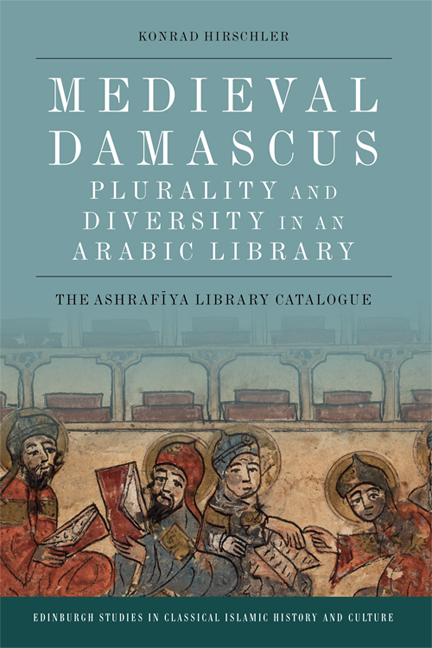Book contents
- Frontmatter
- Contents
- List of Illustrations
- Acknowledgements
- Introduction
- 1 The Making and Unmaking of a Medieval Library
- 2 Organising the Library: The Books on the Shelves
- 3 Plurality and Diversity: The Profile of a Medieval Library
- 4 The Ashrafīya Catalogue: Translation and Title Identification
- 5 The Ashrafīya Catalogue: Edition
- Bibliography
- Index of Subjects
- Index of Titles
- Index of Authors
- Index of External Categories
5 - The Ashrafīya Catalogue: Edition
Published online by Cambridge University Press: 05 August 2016
- Frontmatter
- Contents
- List of Illustrations
- Acknowledgements
- Introduction
- 1 The Making and Unmaking of a Medieval Library
- 2 Organising the Library: The Books on the Shelves
- 3 Plurality and Diversity: The Profile of a Medieval Library
- 4 The Ashrafīya Catalogue: Translation and Title Identification
- 5 The Ashrafīya Catalogue: Edition
- Bibliography
- Index of Subjects
- Index of Titles
- Index of Authors
- Index of External Categories
Summary
The Ashrafiya catalogue has been preserved in a unique manuscript in the Fatih collection in Istanbul, presently housed in the Süleymaniye Library (Fatih 5433, folia 246b–270a). Fatih 5433 is a multiple- text manuscript with texts that, judging from the binding, were most likely bound together in the Ottoman period. The shared characteristic of these texts is that they are all linked with Damascus and that they were all composed in the late Ayyubid/early Mamluk period. The manuscript thus starts on folia 1b to 53b with an anonymous summary of the chronicle The Mirror of Times (Mirʾat al- zaman) by the Damascene scholar SibtIbn al- Jawzi (d. 654/1256), who was closely attached to the city's Ayyubid rulers, among them al- Malik al- Ashraf. Epistles, anecdotes, poems and historical material appear on the following folia up to the Ashrafiya catalogue. These are most likely from the early Mamluk encyclopaedia of the Damascene administrator and adib ʿAli b. al- MuÕaffar al- Wadaʿi (d. 716/1316). The summary and the encyclopaedia are repeatedly interlaced with other texts, such as the ‘spiritual testament’ (wasiya) by the Sufi al- Suhrawardi (d. 632/1234) on folia 104a–105a. After the Ashrafiya catalogue we find on folia 271b to 282b again material from a minor untitled manual by the low- ranking early Mamluk administrator Sulayman b. Musa Abu al- ʿAlaʾ (d. 713/1314).
The Ashrafiya catalogue has no colophon but was, as discussed in Chapter 1, most likely written in Damascus in the 670s/1270s by the librarian Ahmad al- Ansari. The manuscript consists of twenty- five folia of differently coloured wove paper. It is in a very good state of preservation with no lacunae and only occasional stains. The catalogue is written in naskh with partially pointed letters and occasional use of vocalisation. The script is of decreasing quality as the catalogue progresses from a very clear hand in the beginning to a rather sloppy script towards the end. Even though the hand changes, the entire catalogue was written by one scribe. The text is monochrome in black ink. For rubrications, wider word spacing and larger letter sizes are employed. The manuscript is bound in an Ottoman full leather binding on pasteboard without fore-edge flaps. The front and back cover are identically decorated with a framed square.
- Type
- Chapter
- Information
- Medieval Damascus: Plurality and Diversity in an Arabic LibraryThe Ashrafiya Library Catalogue, pp. 442 - 467Publisher: Edinburgh University PressPrint publication year: 2016



